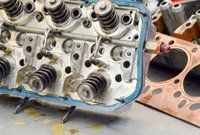


Your car could not run for very long without help from its cooling system. As you probably know, the cooling system provides a way to dissipate the large amounts of heat generated by your engine. One of the most important components of your car's cooling system goes by the name of the water pump.
The water pump provides the force necessary to circulate coolant throughout the engine and radiator. As time goes on, a water pump may develop problems that impact its ability to work normally. This article takes a closer look at three common symptoms of water pump failure.
All water pumps contain a small hole known as the weep hole. The weep hole provides vital information about the health of the seals inside of your water pump. Two such seals exist: the oil seal and the internal water pump seal.
The oil seal ensures that the oil used to lubricate the bearings never comes into contact with the coolant. The internal water pump seal achieves the opposite goal: it keeps coolant where it belongs, thus preventing the coolant from contaminating the bearing oil. Provided your seals remain in good health, no liquids should come out of your weep hole. The one exception to this rule has to do with new water pumps.
A brand-new water pump may leak from the weep hole for around 10 minutes. After this break-in period, the seals should prevent any further leakage. If either coolant or oil comes out of the weep hole, one of the seals has failed. In virtually all cases, this requires that you install a new water pump.
Leaks may also occur around the water pump's mounting surface. Such leaks indicate one of two issues: improper pump installation or a damaged seal or gasket. Improper installation usually means that the bolts used to attach the pump the engine block were not tightened appropriately. A mechanic must ensure that bolts get tightened according to the manufacturer's specified torque.
All water pumps contain one or more gaskets and seals located between the mounting surface and the engine block. These seals ensure that coolant cannot escape as it moves from the pump to the engine. Mounting surface leaks often occur as the result of faulty or damaged gaskets and seals.
This type of leak usually means that the installer either used the wrong type of seal or re-used an old, partially degraded component. Experienced mechanics always use new gaskets and seals when installing a new water pump. Problems may also ensue from the use of additional gaskets or sealing pastes not specifically called for by the pump's manufacturer.
Most water pumps used today consist of commercial-grade steel. This steel does not always exhibit the best rust resistance. Small patches of rust, in other words, do not necessarily indicate a serious problem. However, more extensive corrosion often indicates a blown gasket, which allows coolant to escape onto the mounting surface.
Alternately, rust may indicate that your coolant has become excessively contaminated. Contaminants in your coolant create friction that can lead to pump seal failure. As a result, coolant escapes from the weep hole, often causing rust to form in the vicinity. This issue often results in insufficient pressure levels, which in turn exacerbates the rate of rust formation.
Few parts of your cooling system play as important a role as the water pump. A failed water pump soon leads to overheating and other serious problems. For more information about how to keep your water pump in good working order, contact the experts at Midway Garage & Salvage LLC.














